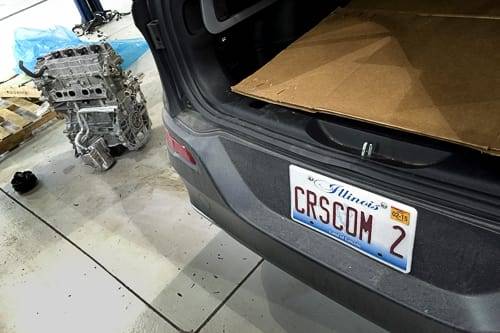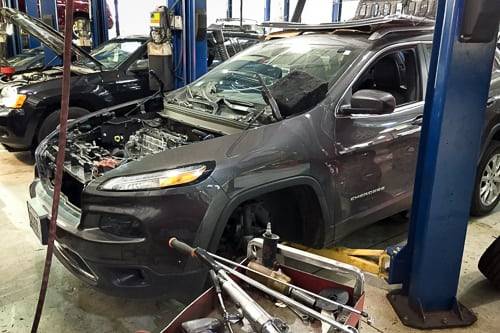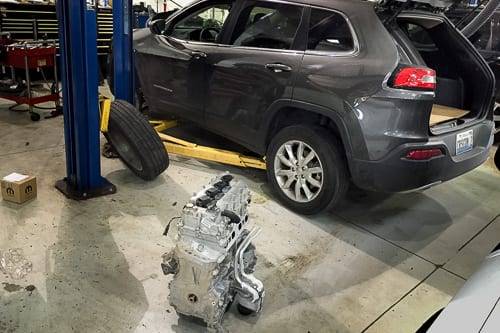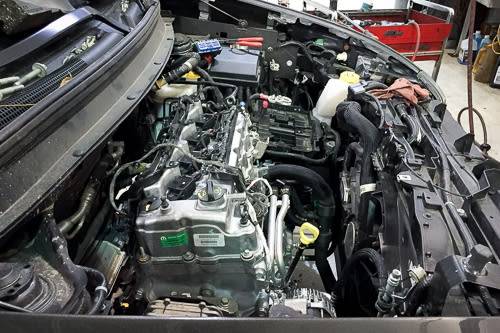Why Jeep Replaced Our 2014 Cherokee's Engine


Jeep replaced the engine in our 2014 Cherokee. Here’s why.
It seemed simple enough. Drop off Cars.com’s long-term Cherokee at our local dealership to diagnose an occasional drivability issue and get the oil changed. Our Jeep Cherokee had thrown a tantrum a few days earlier where the 2.4-liter four-cylinder engine stalled multiple times, but, of course, it was driving perfectly fine en route to the dealership.
Related: Follow Cars.com’s Long-Term Fleet
We thought maybe the Jeep needed a software flash update to the engine’s computer, or maybe a rat had chewed through an engine harness while the SUV sat outside in these cold Chicago temps, as had happened to our Chevrolet Volt. The last thing we expected to hear was that our Cherokee was getting a new engine at only 13,300 miles. After all, the four-cylinder didn’t spectacularly fail in a burst of shattered pistons and connecting rods leaving us stranded on the side of the road. We drove the Cherokee SUV into the service bay under its own power, as it was operating fairly normally.
What the technician found there was surprising, though: excessive amounts of oil had crept into the intake side of the Jeep vehicle’s engine, coating the intake manifold, hoses and an engine management sensor.
We’re not talking about a light coating of oil residue. Oil drained from the intake manifold partially filled a cereal-bowl-sized plastic dish. The Jeep Cherokee’s Manifold Absolute Pressure sensor, a vacuum sensor mounted to the intake manifold that’s used to communicate fueling information to the engine’s computer, was also covered in oil, as were the insides of the vehicle’s crankcase ventilation hoses. Our Cherokee’s engine was approximately 2.5 quarts low from the manufacturer-required 5.5-quart capacity.

The Jeep dealership put in hours with the Mopar Technical Call Center, a repair hotline for dealers to handle issues like ours that don’t have a previously known diagnosis. Our car was charting new ground in Cherokee breakage without a previously recorded instance of similar symptoms. After all types of tests, including internal compression and cylinder leak-down tests to ensure the engine’s internals were sound, the decision was made to replace the engine and ship it back to Jeep for further diagnosis. We received a new engine along with every air intake part replaced, at no charge to us.
“Replacing the engine is [a] very rare thing to do,” said Ann Smith, Fiat-Chrysler Automobiles U.S. spokeswoman. “The problem could very well be a one-off thing, but it’s something we need to look at, and if we need to change something on the line, we can do that, too.”

We contacted a number of industry experts to see if there was any comprehensive accounting of how frequently engines are replaced, but we were unable to find any. However, J.D. Power and Associates provided details from both its Initial Quality Study and three-year Vehicle Dependability Study that show issues that may lead to an engine replacement are uncommon. Over the first 90 days of ownership these issues are extremely rare, one-fifth of 1 percent or less. Over three years, they account for one to two problems per 100 vehicles. However, the existence of these problems — like the engine stalling or not starting — doesn’t mean the engine will eventually be replaced.
Our SUV’s original engine, now back in Jeep’s hands, has undergone preliminary testing where they discovered lower than expected compression in one of the cylinders. We’ll provide an update as soon as we find out Jeep’s final diagnosis on what happened to our Jeep Cherokee’s four-cylinder.
Some questions Cherokee owners may have:
Will every Jeep Cherokee owner get a new engine?
Smith said not everybody would get a new engine. “We are confident in the performance and reliability of the 2.4-liter. The SUV’s engine went through all of our thorough vehicle testing. We have all of the service records in the field for the Cherokee, and your case was an unusual issue we haven’t seen before, which is why we went to that step of replacing the engine.”
Did Jeep only do this because the Cherokee belonged to Cars.com?
We believe our experience mirrored the process of a typical consumer even though our dealership and Jeep knew we were a media outlet. Smith assures us, “Your Cherokee got a new engine because it was determined to be the best fix per the normal dealer service process. The Quality and Service teams reviewed your case and confirmed the dealer service personnel took the right actions to diagnose and fix the vehicle.”
What are the warning signs that my Cherokee’s engine might be in trouble?
Our Cherokee’s check-engine light and engine stalling were good indicators it was time to visit the dealership. “Anytime you see an engine service light in your cluster you want to get it checked out. When in doubt, check with the dealership,” Smith said.
What should concerned Cherokee owners do now?
At the moment, our engine replacement seems to be an unusual case. Smith believes our problem will not affect the majority of Cherokee customers. “Keep in mind, Cars.com experienced something very unusual to take the rare step of replacing the engine. Bottom line, this is not an issue out in the field that a majority of drivers will experience.”

As of now, our Jeep Cherokee is back on the road and has accumulated 500 issue-free miles so far. The Jeep’s four-cylinder still clatters at idle and remains borderline underpowered on the highway, though the new engine revs much smoother than when we dropped the car off for service with the old engine. Through 2014, 40 percent of Cherokees sold are equipped with the 184-horsepower 2.4-liter; the optional 271-hp, 3.2-liter V-6 is the dominant engine in 60 percent of Cherokees, though both options are paired to the same 9-speed auto transmission. That is still thousands of new SUVs a month as the Cherokee has been a popular seller.
We’d like to hear from other Jeep Cherokee drivers if they’ve experienced a similar issue and what the fix has been.
Cars.com photos by Joe Bruzek

Managing Editor Joe Bruzek’s 22 years of automotive experience doesn’t count the lifelong obsession that started as a kid admiring his dad’s 1964 Chevrolet Corvette — and continues to this day. Joe’s been an automotive journalist with Cars.com for 16 years, writing shopper-focused car reviews, news and research content. As Managing Editor, one of his favorite areas of focus is helping shoppers understand electric cars and how to determine whether going electric is right for them. In his free time, Joe maintains a love-hate relationship with his 1998 Pontiac Firebird Trans Am that he wishes would fix itself. LinkedIn: https://www.linkedin.com/in/joe-bruzek-2699b41b/
Featured stories




